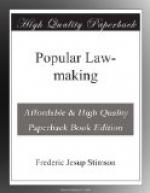The form of the ballot is another matter that has been the subject of much legislation. Our States vary, as does still public opinion in England, between the extreme of providing by the Constitution itself for the secrecy of the ballot, and the other extreme of requiring that all voting should be viva voce, as was formerly the case at least in Kentucky. Public opinion has universally settled in favor of the former; and to protect the voter’s freedom, the so-called Australian ballot has very generally been adopted, the principle, of course, being a ballot on which all candidates’ names are printed, with or without party designations, and against which the voter makes his mark. In their practical working, however, these laws depend on the simplicity of the form; thus, it works very well in Massachusetts, where the form is simple and the ballot short, and very badly in New York, where the contrary is the case. Opinion is pretty well united on the advisability of the Australian ballot, the only remaining difference being as to whether any party designations should be printed. Most practical politicians desire that the name “Republican” or “Democrat,” or even that some party symbol like a star or flag, should be affixed, which can be understood by the most illiterate voter; also, that the voter should be allowed to make one cross opposite the word “Republican” or “Democrat” when he means to vote the whole of the ticket, “in order to give each candidate the benefit of the full party strength.” On the other side it is argued that all voting should be intelligent and never blind, and that if the voter does not take the trouble to mark all the names on the ballot it sufficiently indicates that he is indifferent as to some of the candidates even of his own party, and that his votes for them should, therefore, not be counted.
The most significant of modern developments in legislation concerning voting is the new practice of recognizing by law political parties, and of regulating by law the mode of their nominations. The old idea was that the law took no notice of anything that happened until election day, when it did regulate the mode of voting and counting the votes; the law was supposed to be blind to political parties; the persons elected were merely the successful candidates. But first began the tendency to recognize parties in “bi-partisan” boards and commissions; it became very usual to provide that State officials should, when the office was held, or the function performed, by more than one person, be elected or appointed from different parties. This, of course, works very well when there are but two parties, as indeed is usually the case. And now of late years the practice has grown up of regulating political matters before the election day. Direct primaries, caucuses regulated by law, the mode of nomination, nomination papers to be filed in a certain manner, the compulsory service of men as candidates unless they comply with precise formalities of resignation,




